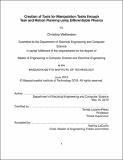Creation of tools for manipulation tasks through Task and motion Planning using differentiable physics
Author(s)
Wettersten, Christina.
Download1127649344-MIT.pdf (3.937Mb)
Other Contributors
Massachusetts Institute of Technology. Department of Electrical Engineering and Computer Science.
Advisor
Tomás Lozano-Pé́rez.
Terms of use
Metadata
Show full item recordAbstract
Toussaint et al. [1] have proposed a novel embedding of dynamic physical manipulations within a Task And Motion Planning (TAMP) framework to achieve a subset of sequential manipulation tasks involving tools. The work, in part, mimics the human ability to plan using an 'intuitive physics engine' [2] by using physics-based primitives in task planning. The primitives are described by the stable kinematic or differentiable dynamic and impulse exchange constraints they impose on the robot during motion planning. By altering and expanding the set of primitives, to include modification and recombination of items in the work space, I present an expansion upon this approach using to achieve not only tool use, but tool creation. The new approach is then tested on three classes of problems: rerunning previous tool use problems, problems designed to recreate previously seen tools and manipulation problems in workspaces with significant obstacles.
Description
This electronic version was submitted by the student author. The certified thesis is available in the Institute Archives and Special Collections. Thesis: M. Eng., Massachusetts Institute of Technology, Department of Electrical Engineering and Computer Science, 2019 Cataloged from student-submitted PDF version of thesis. Includes bibliographical references (pages 58-62).
Date issued
2019Department
Massachusetts Institute of Technology. Department of Electrical Engineering and Computer SciencePublisher
Massachusetts Institute of Technology
Keywords
Electrical Engineering and Computer Science.